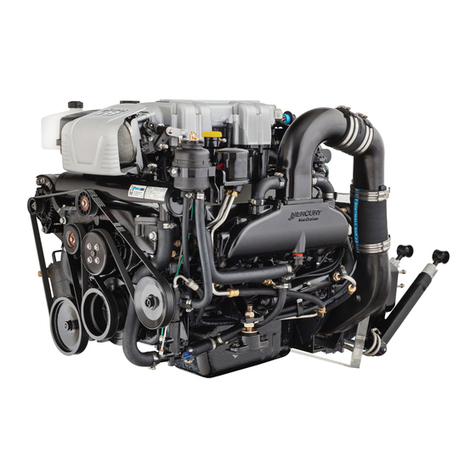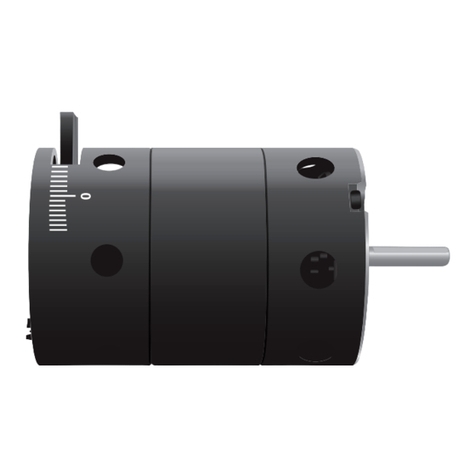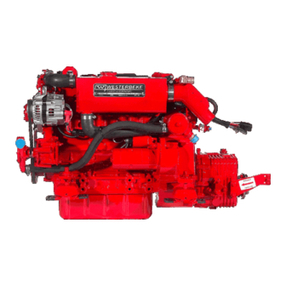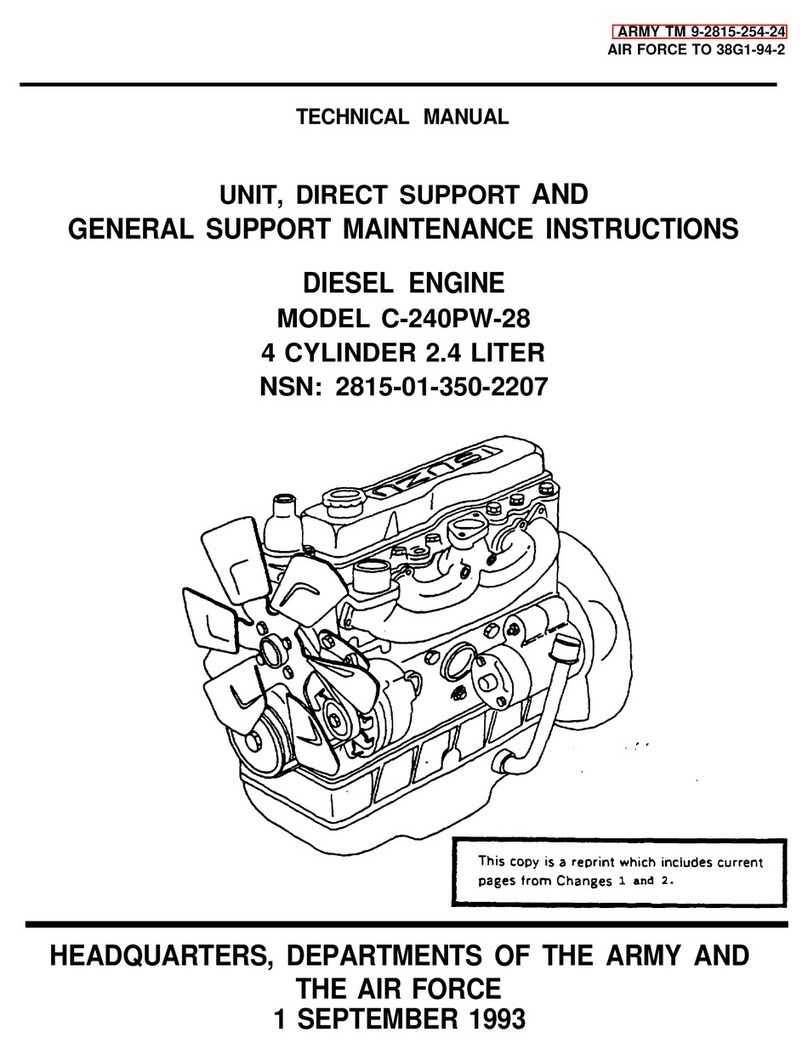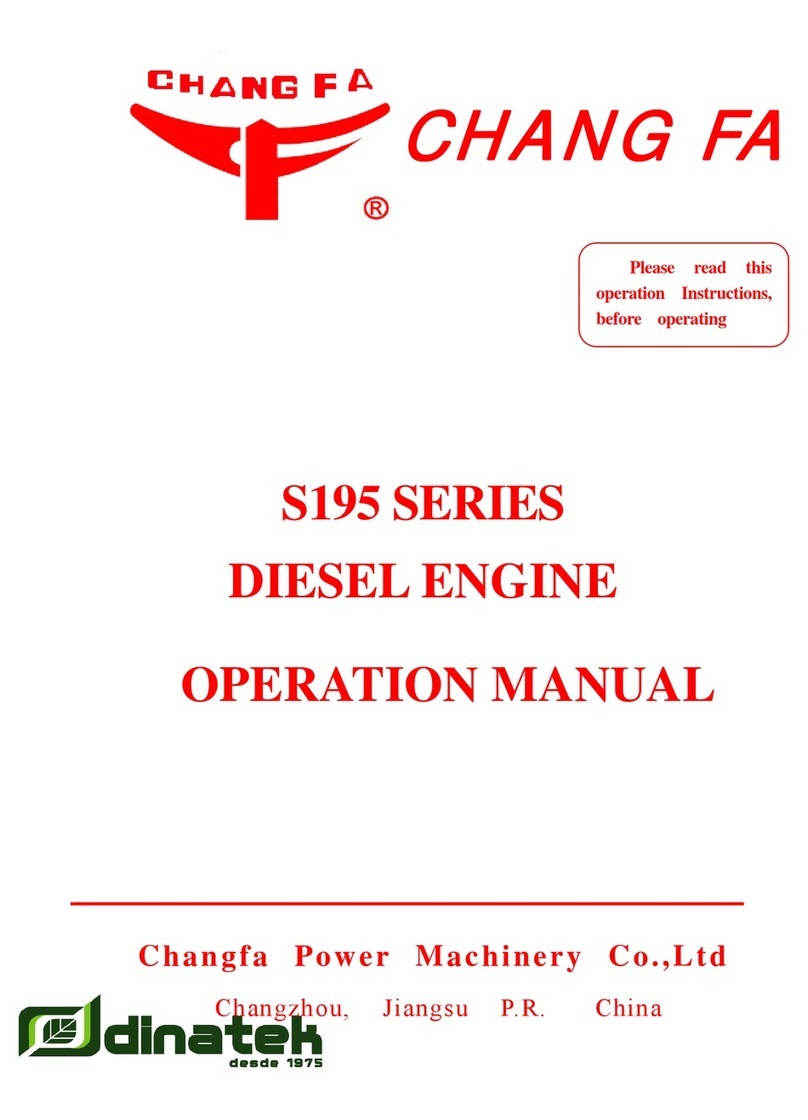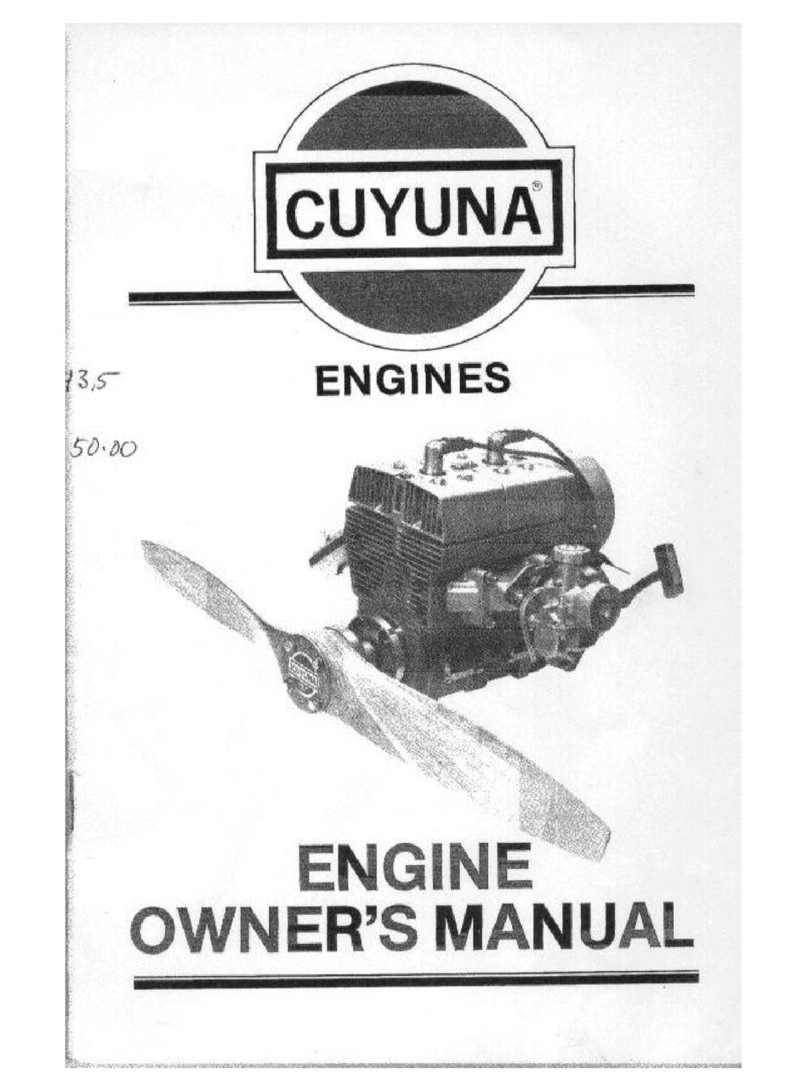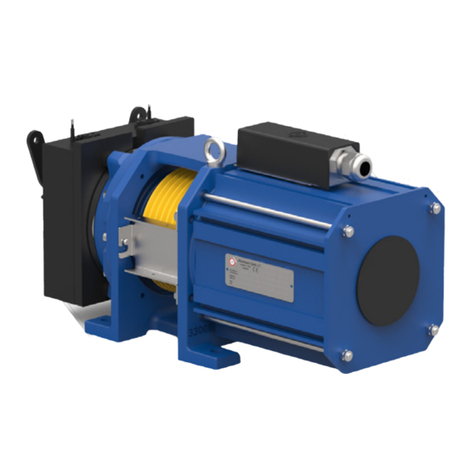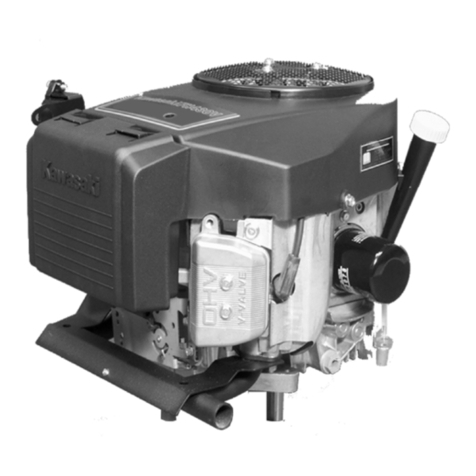Eicher EE483TC User manual

Pub. No : M190456 : 01 Nov 2012
OPERATION AND MAINTENANCE MANUAL
EE483TCI Power Generation EngineEE483TC &

1
CONTENTS
Section
Details
Page No
Part I Introduction-Operation & Maintenance
Manual 2
Part II Eicher Engine - General Information 3
Part III
Engine Familiarization
3 General Information 4
3.1- Engine Identification 4
3.2- Engine Nomenclature 5
3.3- Engine orientation and Parts
Illustration 6 to 8
3.4- Technical Specification- Engine 9 to 10
3.5- Engine Systems and Function 11
3.5.1- Air Intake and Exhaust System 11 to 13
3.5.2- Lubrication System 14 to 17
3.5.3- Fuel System 17 to 19
3.5.4- Cooling System 20 to 21
Part IV Engine Electrical System 22 to 23
Part V Safety Guidelines 24 to 25
Part VI Recommended Routine Checks By user 26 to 28
Part VII Engine Inspection and Maintenance 29 to 38
Part VIII Trouble Shooting Guidelines 39 to 47

2
PART I-INTRODUCTION - OPERATION & MAINTENANCE MANUAL
We are glad to introduce us as VE Commercial Vehicles Ltd (VECV), manufactures of EICHER EE483TC and
EE483TCI Power Generation Engine owned by you. VECV is committed to being the leader in customer
satisfaction in India and emerging markets. We put our best efforts to maintain global quality levels by
understanding andfulfilling customer needs.
This manual presented to you gives a comprehensive understanding on Construction, operation and
Maintenance aspects of Engine for the intended application.
These Engines meets current prevailing emission norms.
Due care has been taken in preparing this manual. However due to Continuous improvements product
specifications and illustrations are likely to undergo change without any prior notice.
For any further information, please write to:
PRODUCT SUPPORT
NON AUTOMOTIVE ENGINES
VE Commercial Vehicles Limited
(A Volvo Group and Eicher Motors Joint Venture)
102, Industrial Area No. 1 Pithampur 454775 Dist. Dhar (M.P.) India
Phone:(07292) 402633
Fax: (07292) 402611
PUBLICATION NO: M190456:00 REVISION NO: 01
PUBLICATION MONTH: NOVEMBER’2012 REVISIONDATE: 01/11/2012

3
PART II: EICHER ENGINE GENERAL INFORMATION:
Eicher EE483TC Engines manufactured by VE Commercial Vehicles Ltd (VECV) are direct injection, four
Strokes, Water cooled, and Turbo charged Diesel Engines designed to suit Power Generation application.
Eicher EE483TCI Engines manufactured by VE Commercial Vehicles Ltd (VECV) are direct injection, four
Strokes, Water cooled, Turbo charged, Intercooled Diesel Engines designed to suit Power Generation
application.
The engines are eco-friendly, reliable and fuel efficient meets prevailing statutory emission standards.
While we, at manufacturing and testing have taken due care to ensure trouble free performance, as an
engine owner and user, proper up keep of engine, use of genuine parts, use of Genuine oil and Lubricants,
use of Genuine Coolant and adherence to scheduled and preventive maintenance shall derive the bestout of
your engine resulting in Value for investment.

4
PART III: ENGINE FAMILIARIZATION
3. GENERAL
This part provides details about engine identification, engine Sl No nomenclature, Orientation, technical
specifications and various Systems of engine.
3.1 ENGINE IDENTIFICATION.
Engine is identified with the engine nameplate fitted on flywheel housing on left hand side of the engine
when viewed from front. Engine name plate contains the information as shown in the figure 1, 2 and 3.
Engine Sl No is also punched on the Cylinder block as shown in the figure 4.
Fig-
1- EE483TC-38 Kw
Fig 2 – EE483TC-48Kw
Fig-3-EE483TCI-59 Kw
Engine Sl No Punched on Cylinder Block
Fig-4

5
3.2 ENGINE NOMENCLATURE:
EE 4 83 C D B A 100000 G
Running Serial number
Month of production (A to M), A= Jan
& M= Dec.
Note: “I” is omitted
Year of production (A to W), A= 2010
W=2028.
Note: “I” is omitted
Type of fuel used
(D=Diesel)
Version: N=NA (Naturally aspirated)
C= TCI (Turbo Charged intercooled)
T=TC (Turbo Charged)
Swept Volume per cylinder
83=0.83 Litres
No. of Cylinders (4 or 6)
EICHER
G- Identification for Power
Generation Engine

6
3.3 ENGINE ORIENTATION AND PARTS ILLUSTRATION (EE483TC -TURBO CHARGED ENGINE):
1
2
3
4
5
6
7
8
9
10
11
12
13
14
15
16
17
18
19
20
21
22
23
24
25
26
1
Radiator
14
Strip
-
Supportradiator
2
Radiator Cap
15
Shroud Radiator
3
Hose
-
Radiator In
16
Guard Fan Radiator
4
Tank Condenser
17
Fan Cooling Radiator
5
Bracket
–
Radiator Support
18
Pipe
-
Fuel filter to Fuel injection pump
6
Cushion
-
Radiator SupportBracket
19
Stop Solenoid
7
Cap Oil Filler
20
Feed pump
8
Pipe
-
Turbo to Intake Manifold
21
Pipe fuel
-
Feed Pump to fuel filter
9
High Pressure Pipe
22
Fuel injection Pump
10
Rocker Cover
23
Oil Sump
11
Hose
-
Turbo out
24
Starter Motor
12
Hose
Breather
25
Dip
Stick
13
Air cleaner Assembly
26
Flywheel

7
ENGINE ORIENTATION AND PARTS ILLUSTRATION (EE483TC -TURBO CHARGED ENGINE) CONTD:
27
28
29
30
31
32
33
34
35
36
37
38
39
40
41
42
43
44
45
46
27
Hose
–
Air cleaner
37
Pedestal
-
Rear
for Transportation
28
Switch
-
Choke Air Cleaner
38
Hose
-
turbo charger in
29
Pipe
-
Lubrication Turbocharger
39
Turbo charger
30
Manifold
-
Exhaust
40
Filter Oil
–
Main
31
Cooler
-
Oil
41
Bend Exhaust
32
Manifold
-
Intake
42
Filter
-
By Pass
33
Switch Cum
Sensor
-
Water Temperature
43
Pedestal
–
Front
34
Pipe
-
Air Cleaner to Turbo
44
Sensor
-
oil Pressure
35
Housing flywheel
45
Alternator
-
Battery charging
36
Engine Identification plate
46
V Belt
-
Engine/Alternator/Water
pump

8
ENGINE ORIENTATION AND PARTS ILLUSTRATION (EE483TCI -TURBO CHARGED INTERCOOLED ENGINE):
1
2
3
4
5
6
7
8
1
Hose
-
Air Filter to Pipe TC in B
5
Intercooler Assy
2
Pipe TC in B
6
Hose
–
Thermostatto Radiator
3
Hose
-
Intercooler Outlet
7
Pipe
-
Turbo
Charger to Intercooler inlet
4
Pipe TC in A
8
Hose
-
Pipe Intercooler inlet to Intercooler in

9
3.4 ENGINE TECHNICAL SPECIFICATIONS:
Parameters Unit Details
40 Kva 50 Kva 62.5 Kva
Engine Manufacturer Name VE Commercial Vehicles Ltd
Engine Make Make EICHER
Engine Model Model EE483TC EE483TC EE483TCI
Emission Compliance Standard CPCB1 – As Per GSR 448 (E) 12.07.2004
No of Cylinders Nos. 4
Engine Configuration Configuration Inline / 4 Stroke
Engine Aspiration Type Turbo Charged Turbo Charged
Inter cooled
Engine Fuel Type High Speed Diesel
Combustion Chamber Type Type Direct injection
Cylinder Bore X Stroke Mm 100 X 105
Engine Displacement Litres 3.3
Compression ratio Ratio 17:1 ± 0.5 mm
Engine Rated Output Kw ( HP) @ RPM 38 (52) @
1500 48 (65) @
1500 RPM 59 (80) @ 1500
Standard Operating
Conditions
Ambient /
Relative Humidity
/ Altitude
25°C / 40 % / 1000 mbar
Engine Deration Applicability Above 4000 feet
Rating Standard Standard IS10000
Overload Permissibility 10 % over load Permissible for 1 Hour in Every
12 Hours of Operation
Governing Standard Standard BS5514 / IS 10000
Governing Class Class A 1
Engine Low Idling Speed RPM 700 ± 50
Engine Fly Up Speed RPM 1560 ± 10
Engine Firing order Sequence 1-3-4-2
Direction of Rotation Direction Anti Clock wise when viewed from Flywheel End
Flywheel Standard SAE J 620 SAE 10 SAE 11.5
Flywheel Housing Standard SAE J 620 SAE 3 SAE 2
Lubrication Method Method Oil Pump Forced feed system
Oil Pump Type Gear Type
OilFilter-Main Type / Nos. Paper Type / Single
OilFilter-By Pass Type Spin on Type Paper
Oil Cooler Type Shell Type
Engine Lubricating Oil Specification /
Grade /
Recommendation
API CH4-SAE 15W40 / EICHER Premium Diesel
Engine Oil

10
Parameters Unit Details
40 Kva 50 Kva 62.5 Kva
Lubricating Oil Consumption % of Fuel
Consumption
< 0.15 %
Minimum Lubricating Oil
Pressure @ Low Idle Bar 1.5
Max Lubricating Oil Pressure
@ Fly up Speed Bar 5.5
Fuel Injection Pump Make/Type Bosch / Inline
Fuel Filter Type / Nos. Cartridge type / 2 Nos.
Cooling Method Method Liquid Cooling / Forced Circulation
Water Pump Type Centrifugal
Coolant Specification /
Recommendation
JIS-K-2234-94 / EICHER GENUINE RADIATOR
COOLANT
Engine Cooling Fan Type Pusher
Electrical System V 12
Starter Motor Make / V / Kw Bosch / 12 / 1.9 Kw Bosch / 12 / 3.2
Battery Charging Alternator Make / V / Amps Bosch / 14 / 49
Shut off Solenoid Type Energise to Stop
Switch – Low Oil Pressure Applicability Yes
Switch – High Coolant
Temperature Applicability Yes
Switch- Air Cleaner Choke Applicability Yes
Sensor-Water temperature Applicability Yes (Integral Design with Switch)
Sensor-Lubricating Oil
Pressure Applicability Yes

11
3.5 ENGINE SYSTEMS AND ITS FUNCTION:
As we all know, Diesel engine is a prime mover developing useful power. Air and fuel is required to produce
power. Lubrication is necessary for the moving parts of the engine. Continuous cooling is required to
dissipate heat generated during combustion. Electrical system is required for engine starting, battery
charging and sensing of critical engine operating parameters.
The construction of Eicher diesel engine is divided in to five parts as below.
1Air intake and Exhaust System
2Lubrication System
3Fuel System
4Cooling System
5Electrical System
The below section provides details of function, key components and working principle of respective system
to understand better about Engine aspects.
3.5.1 AIR INTAKE AND EXHAUST SYSTEM
TURBO CHARGED INTERCOOLED ENGINES:
The function of air system is to supply clean, cool and sufficient quantity air required for proper combustion
of the fuel which results in designed power output of the engine and maintains emissions as per statutory
norms.
Air intake system facilitates cleaning of air, induction of air, compression of air through turbocharger and
cooling by intercooler.
Air is sucked from atmosphere and passed through the Air filter to restrict dust and other foreign particles
from entering into air intake system. Clean air is then induced and compressed by the turbocharger
compressor wheel. Turbocharger increases the temperature of the air. This high temperature air is then
passed through an intercooler which decreases its temperature. As air inducted cools down its density is

12
further increased. Due to more air with desired density of air inducted into the engine there will be complete
combustion resulting in:
•Increase in power and torque without increasing the size of the engine.
•Improves fuel economy.
•Reduce engine noise.
•More complete combustion resulting in cleaner emission
TURBO CHARGED ENGINES:
In turbo charged engines, intercooler will not be present. The Compressed air from turbo charger will be
directly inducted into the combustion chamber. The combustion parameters will be designed to suit the air
temperature inducted in to the combustion chamber and accordingly desired quantity of fuel will be
supplied to ensure better fuel economy and complete combustion to achieve emission characteristics.
AIR FILTER:
Air filter is fitted on the Suction Side. It is paper cartridge dry type air filter comprising of inner and outer
element. Air filter prevents dust and other foreign particles entering intothe air inlet system. The restriction
Indicator fitted on the filter gives indication when air filter gets clogged.
Do not run the engine with clogged air filter. Clogged air filter reduces
power output, fuel efficiency; higher exhaust emissions and affects
engine performance.
Air filter outer element shall be cleaned whenever the restriction
indicator gives indication. There are limitations for cleaning as
frequent cleaning affects air filter filtration efficiency. Follow the
recommendation for cleaning procedures and permissible number of
cleaning.
The inner element should not be cleaned and it should be replaced.
Never run the engine without air filter. Running without air filter will cause foreign object entering into air
system and results in turbocharger and engine failures.
TURBO CHARGER:
The exhaust gases discharged from the combustion chamber are driven out through the exhaust manifold
into the turbo charger and accelerated in the turbine housing to turn the turbine wheel driving away the
Exhaust gases through the muffler to the atmosphere.
Simultaneously, the compressor wheel mounted on the same shaft spins at the designed speeds. The
centrifugal action draws air from air cleaner and builds up the boost pressure in the intake system.

13
SILENCER:
Silencer is used to reduce the noise of exhaust gas /
Smoke.
The exhaust gas is sent through a number of small holes
provided inside the silencer which results in sudden
expansion of exhaust gases.
This results in reduction in exhaust noise.
For specific applications like Power Generation residential
mufflers are used to achieve reduction in noise levels.
INTER COOLER (APPLICABLE FOR TURBO CHARGED INTERCOOLED ENGINES):
Compressed hot air from turbocharger flows through the
tubes of intercooler.
Pusher type radiator cooling fan charges Cold air through the
intercooler fins carries away the heat from compressed hot air
flowing through the intercooler tubes thereby reducing the
temperature of air to the designed temperature levels. This
compressed cold air rushes in tothe combustion chamber.

14
3.5.2 LUBRICATION SYSTEM:
The engine has a forced lubrication system. The main functions of the Lubrication systems are as follows:
•Lubricates moving engine parts by forming a thin film of oil between components and prevents
metal to metal contact
•This oil film is capable of absorbing shocks in Con-rod Bearings and Gear train
•Flowing oil absorbs heat and cools engine parts
•Oil also collects carbon & metal particles formed during engine operation and flows it to the oil pan
•Oil neutralizes the acids and alkali produced during engine operation & prevents corrosion
•Seals compression by forming a thin oil film on cylinder liner walls
ENGINE OIL FLOW PATH:

15
SCHEMATIC DIAGRAM OF LUBE OIL FLOW:
1. Oil Strainer 4B. Bypass valve 8C. Timing gear 15. Auxiliary gallery
2. Oil Pump 5. Main oil gallery 9. Connecting rod bearing 16. Oil jet for piston cooling
2A. Relief valve 6. Engine oil pressure switch 10. Camshaft bushing 17 Piston
3. Oil cooler 7. Bypass filter 10A. Camshaft bushing no.1 18 Conrod bushing
3A. Bypass valve 7A. Restriction orifice 11. Rocker bushing 19. vacuum pump
3B. Regulator valve 8. Crankshaft main bearing 12. Push rod 20. Turbocharger
4. Filter element 8A. Crankshaft main bearing no. 1 13. Tappet 21. Oil sump
4A.Oil bypass alarm 8B. Idler bushing 14. Pressure control valve 22.Fuel Pump
The oil required for lubricating the engine parts is sucked by the oil pump from the sump through the
strainer.
The pressurised engine oil is then sentto oil cooler, where the oil is cooled and then it is sent to the oil filter
for filtration.
The filtered oil is then sent to all engine parts through main oil gallery. By pass oil filter is provided for fine
filtration.
LUBE OIL PUMP: The oil pump is of gear type and is driven by the skew gear
mounted on the camshaft.
The oil pump cover also serves as the oil filter head, requiring no
oil pipe.
Engine oil is pressurised to the required pressure by the oil pump
and sent to various parts for lubrication and cooling.
22

16
OIL COOLER:
Shell type oil cooler facilitates heat dissipation from engine
lubricating oil and maintains engine lubricating oil temperature and
viscosity to the desired levels.
The Pressurised oil from oil pump is sent into the oil cooler for
cooling the hot engine oil. The coolant from the cylinder block is
passed through oil cooler element, which takesaway the heat from
the engine oil.
LUBE OIL FILTER:
The full flow barrel type paper filter removes carbon and fine metal
particles formed during normal operation of engine. The filtered oil
is sent to Main oil gallery.
BY PASS FILTER:
The Spin on type by pass filter mounted on engine block through
adopter which has a small orifice is used for fine filtration of
lubricating oil.
The bypass filter allows a portion of main gallery oil to flow
through it & back to the oil pan through an adopter having a small
orifice.
During replacement the whole filter to be replaced
TURBO CHRAGER LUBRICATION:
Oil from oil main gallery flows through the oil tube to bearing housing
of turbocharger to lubricate bearing and is returned through the
outlet tube at the bottom of the bearing housing through the crank
case and to the oil pan.

17
FUEL INJECTION PUMP LUBRICATION:
Oil from oil gallery flows through benzo tube to FIP & lubricates
camshaft and governor mechanism and then drained to the oil
sump from the FIP gear side of FIP housing.
3.5.3 FUEL SYSTEM:
The function of fuel system is to feed the engine with clean and sufficient quantity of fuel as per designed
requirements.
Fuel Tank Feed pump Fuel Filter Fuel Injection Pump Injection
Nozzle Return line Diesel tank
The fuel system consists of the injection pump, fuel filter, injection nozzle, injection pipe and other parts. Fuel
is fed from the fuel tank through suction pipe to the feed pump of the fuel injection pump assembly and then to
the fuel filter, injection pump and injection nozzle.
The excess fuel is returned from the Nozzle to injection pump and to the fuel tank.
Pipe Lubrication - FIP

18
WATER SEPARATION FROM FUEL:
The air moisture trapped inside the fuel tank gets condensed during night time, becomes water and mixes
with diesel. If this water is allowed toflow through the fuel system it can damage the FIP and nozzle.
Since the engines are used for power generation application which is operated under stationery condition,
the fuel tank acts as water separator. The foreign particles in fuel are collected as sediments in fuel tank
bottom and water in fuel are collected at the bottom of the fuel tank. Ensure periodical draining of water
from fuel tank through the drain plug provided in the fuel tank.
Ensure periodical cleaning of Fuel tank to make it free from Sediments.
Do not top up fuel in fuel tank when the engine is under operation as the process will allow sediments and
water to float andgets carried away along with fuel.Always top up fuelin fuel tank when the engine is notin
operation. Wait for few minutes and allow sometime for sediments and water to settle at the bottom of the
fuel tank before starting the engine.
FEED PUMP:
The feed pump is driven by the Fuel injection pump
camshaft.
The priming pump allows manual lift of fuel when the
injection pump is stationary. It may be used when bleeding
the system.
The gauze filter removes large particles of dust from the fuel
lifted from the fuel tank, preventing the feed pump from
getting clogged. The filter must be washed in clean diesel
periodically.
FUEL FILTER:
The fuel from the feed pump is supplied to fuel filter for filtration. The dual filter is of element type and
replaceable individually.

19
Fuel from feed pump flows into the outer side of the filter housing and filtered by the elementand supplied
to the fuel injection pump. The above diagram shows the flow path of fuel in fuel filter.
FUEL INJECTION PUMP:
The Bosch in line type fuel injection pump is used. The injection
pump, that forces fuel into the injection nozzle under pressure is
provided with a mechanism to increase or decrease the amount of
fuel. It has one plunger and delivery valve for each cylinder.
The plunger pushed up by the camshaft and pushed back by the
plunger spring, moves up and down in the plunger barrel on a
predetermined stroke to feed fuel under pressure. In doing so it
opens and closes the suction and discharge ports to adjust the fuel
injection rate.
The Constant speed governor of the fuel injection pump is capable of holding rated speed steadily
irrespective of variation in loads.
INJECTION NOZZLE:
The injection nozzles are of the hole type. The fuel delivered from
the injection pump enters the nozzle holder. Whenit reaches the
specified pressure value, the fuel overcomes the spring force to push
up the needle valve of the nozzle tip, spraying from the injection
orifice at the end of nozzle into the cylinder.
The injection pressure can be adjusted by increasing or
decreasing the number of washers in the spring.
This manual suits for next models
1
Table of contents
Popular Engine manuals by other brands
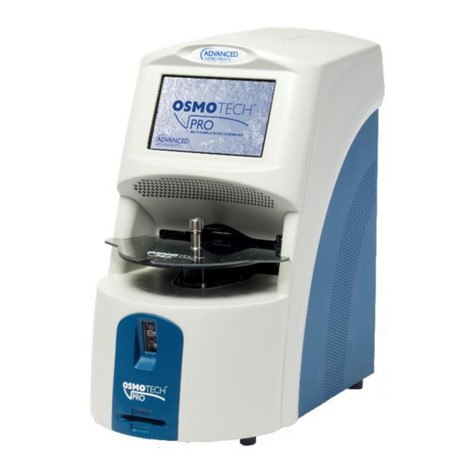
Advanced Instruments
Advanced Instruments OsmoTECH PRO quick start guide

Suzuki
Suzuki F6A Service manual
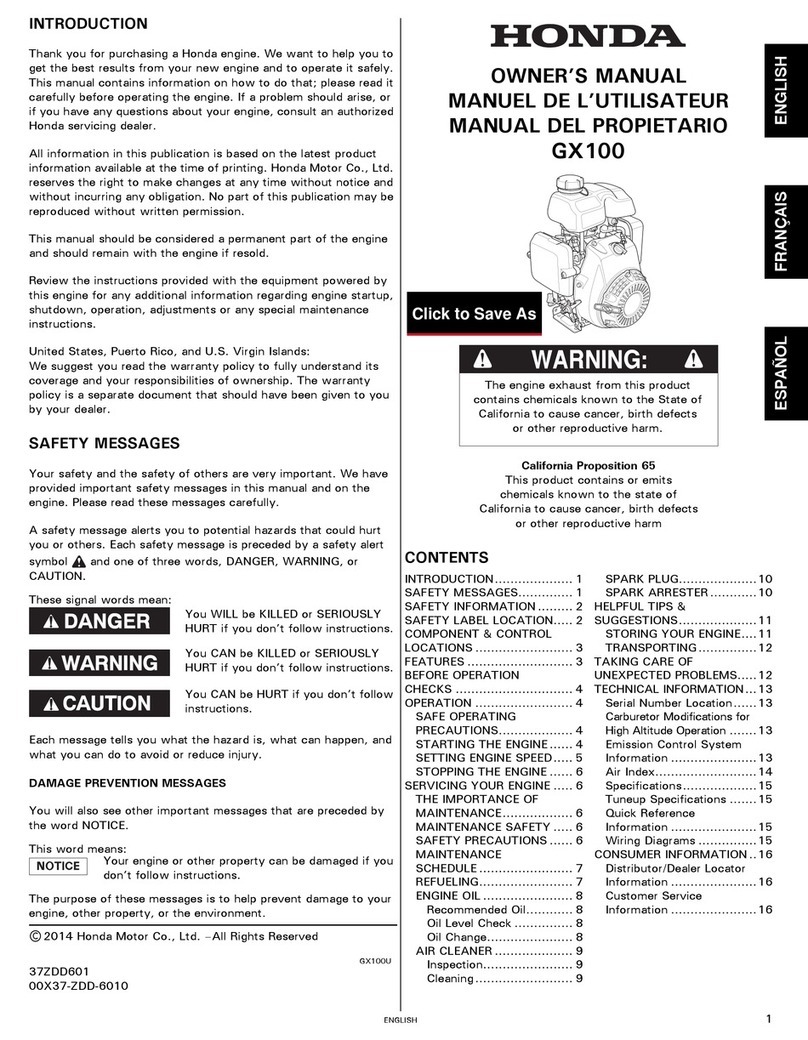
HOND
HOND GX 100 owner's manual
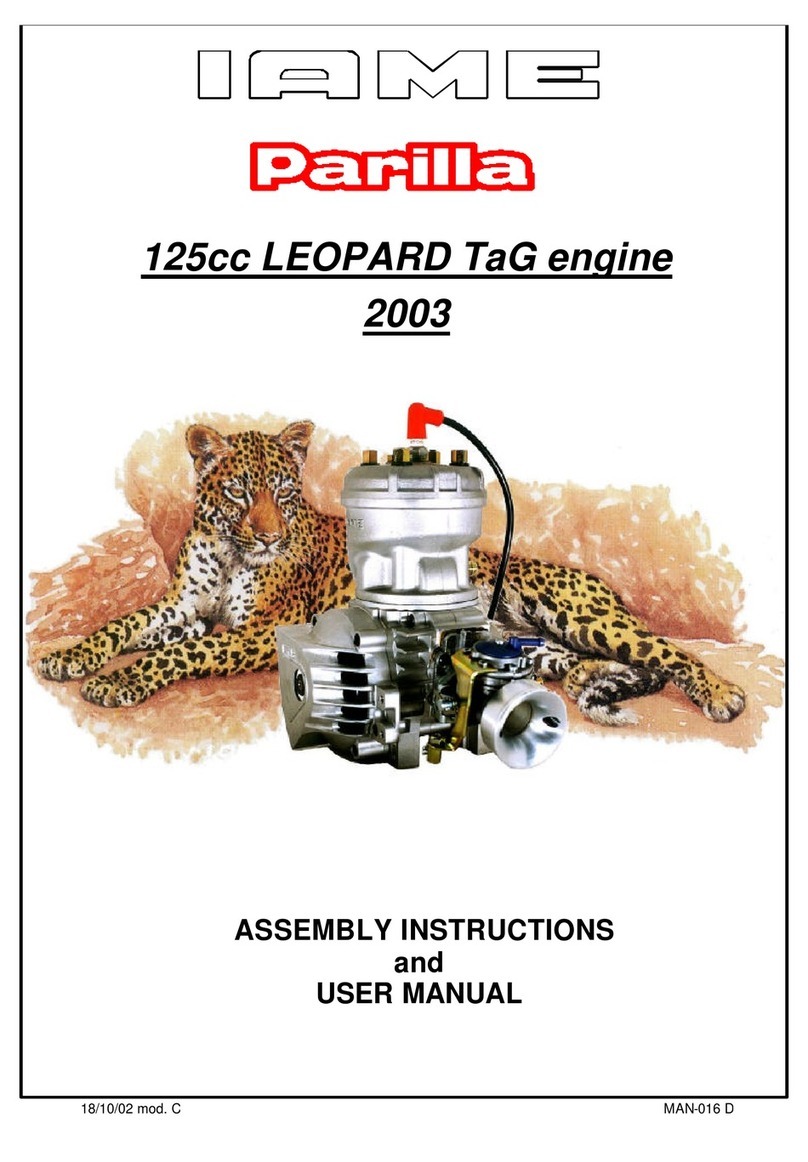
IAME
IAME 125cc LEOPARD TaG Assembly instructions and user's manual
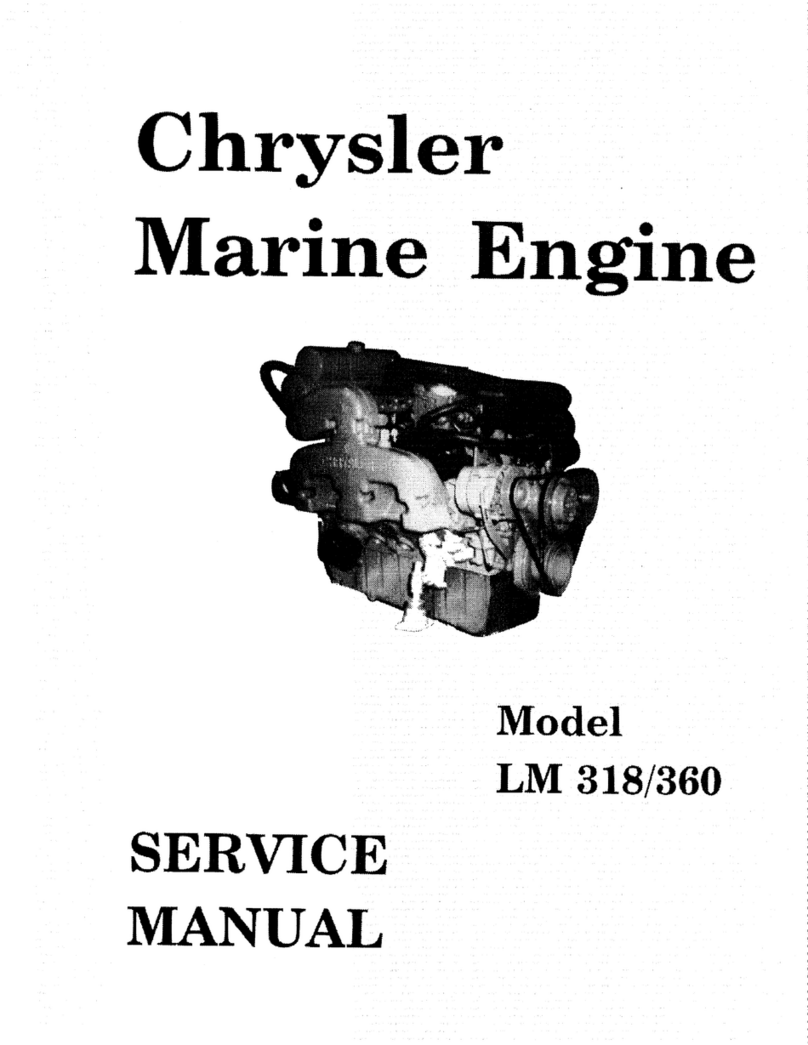
Chrysler
Chrysler LM 318 Service manual

Continental Motors
Continental Motors C75 Instruction and service manual
